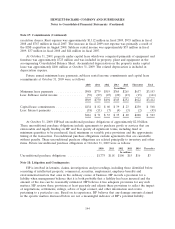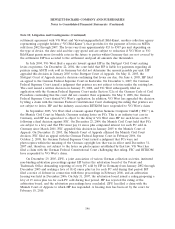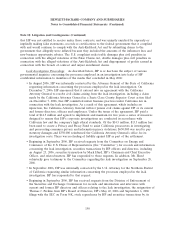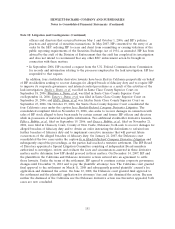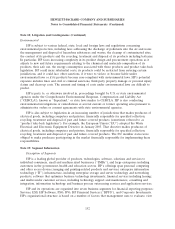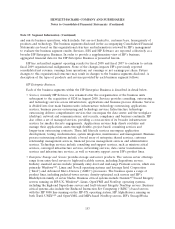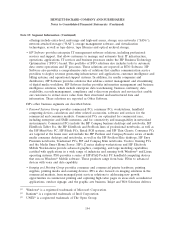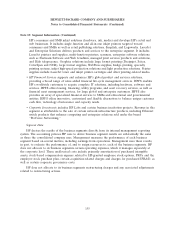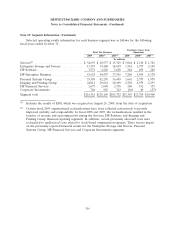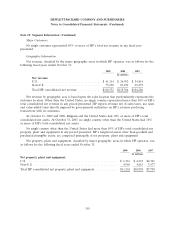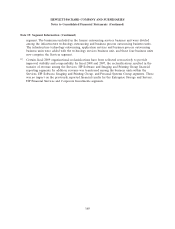HP 2009 Annual Report Download - page 159
Download and view the complete annual report
Please find page 159 of the 2009 HP annual report below. You can navigate through the pages in the report by either clicking on the pages listed below, or by using the keyword search tool below to find specific information within the annual report.HEWLETT-PACKARD COMPANY AND SUBSIDIARIES
Notes to Consolidated Financial Statements (Continued)
Note 18: Litigation and Contingencies (Continued)
Environmental
HP is subject to various federal, state, local and foreign laws and regulations concerning
environmental protection, including laws addressing the discharge of pollutants into the air and water,
the management and disposal of hazardous substances and wastes, the cleanup of contaminated sites,
the content of its products and the recycling, treatment and disposal of its products including batteries.
In particular, HP faces increasing complexity in its product design and procurement operations as it
adjusts to new and future requirements relating to the chemical and materials composition of its
products, their safe use, the energy consumption associated with those products and product take-back
legislation. HP could incur substantial costs, its products could be restricted from entering certain
jurisdictions, and it could face other sanctions, if it were to violate or become liable under
environmental laws or if its products become non-compliant with environmental laws. HP’s potential
exposure includes fines and civil or criminal sanctions, third-party property damage or personal injury
claims and clean up costs. The amount and timing of costs under environmental laws are difficult to
predict.
HP is party to, or otherwise involved in, proceedings brought by U.S. or state environmental
agencies under the Comprehensive Environmental Response, Compensation and Liability Act
(‘‘CERCLA’’), known as ‘‘Superfund,’’ or state laws similar to CERCLA. HP is also conducting
environmental investigations or remediations at several current or former operating sites pursuant to
administrative orders or consent agreements with state environmental agencies.
HP is also subject to legislation in an increasing number of jurisdictions that makes producers of
electrical goods, including computers and printers, financially responsible for specified collection,
recycling, treatment and disposal of past and future covered products (sometimes referred to as
‘‘product take-back legislation’’). For example, the European Union (‘‘EU’’) adopted the Waste
Electrical and Electronic Equipment Directive in January 2003. That directive makes producers of
electrical goods, including computers and printers, financially responsible for specified collection,
recycling, treatment and disposal of past and future covered products. The EU member states were
obliged to make producers participating in the market financially responsible for implementing these
responsibilities.
Note 19: Segment Information
Description of Segments
HP is a leading global provider of products, technologies, software, solutions and services to
individual consumers, small and medium sized businesses (‘‘SMBs’’), and large enterprises including
customers in the government, health and education sectors. HP’s offerings span personal computing
and other access devices; imaging and printing-related products and services; enterprise information
technology (‘‘IT’’) infrastructure, including enterprise storage and server technology and networking
products; software that optimizes business technology investments; financial services including leasing;
and multi-vendor customer services, including technology support and maintenance, consulting and
integration, information technology and business process outsourcing services and application services.
HP and its operations are organized into seven business segments for financial reporting purposes:
Services, ESS, HP Software, PSG, IPG, HP Financial Services (‘‘HPFS’’), and Corporate Investments.
HP’s organizational structure is based on a number of factors that management uses to evaluate, view
152




